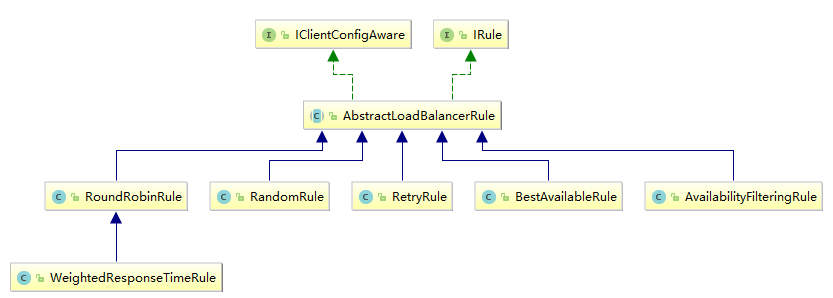一、概述
1.是什么
Spring Cloud Ribbon是基于Netflix Ribbon实现的一套客户端负载均衡的工具。
简单的说,Ribbon是Netflix发布的开源项目,主要功能是提供客户端的软件负载均衡算法和服务调用。Ribbon客户端组件提供一系列完善的配置项如连接超时,重试等。简单的说,就是在配置文件中列出Load Balancer(简称LB)后面所有的机器,Ribbon会自动的帮助你基于某种规则(如简单轮询,随机连接等)去连接这些机器。我们很容易使用Ribbon实现自定义的负载均衡算法。
2.官网资料
(1).https://github.com/Netflix/ribbon/wiki/Getting-Started
(2).Ribbon目前也进入维护模式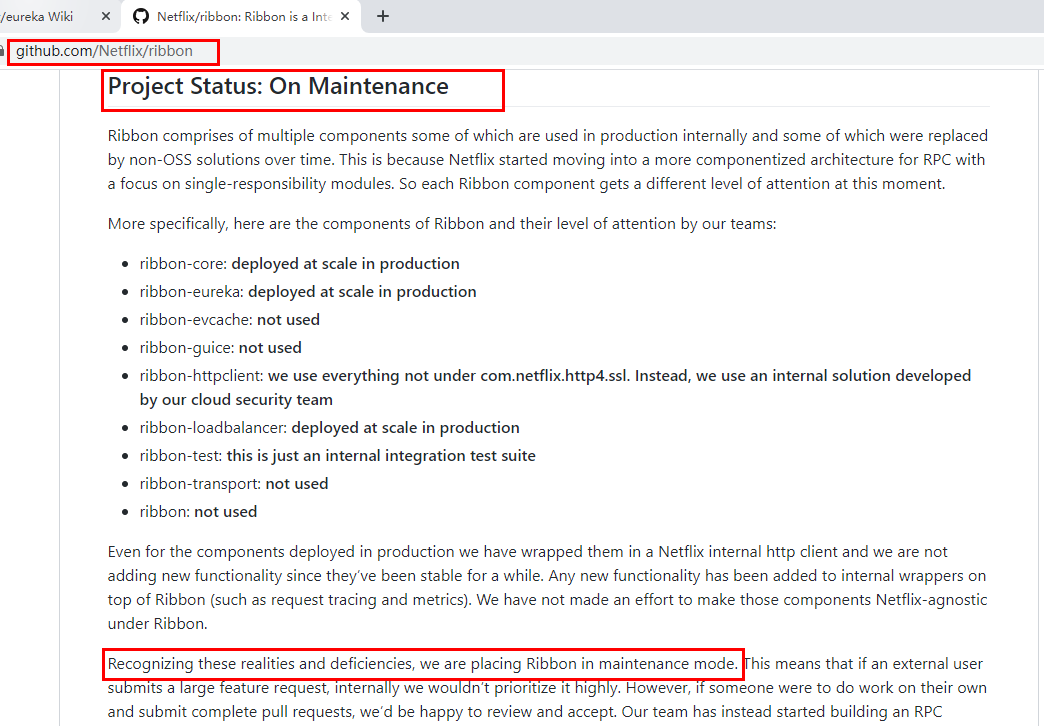
(3).未来替换方案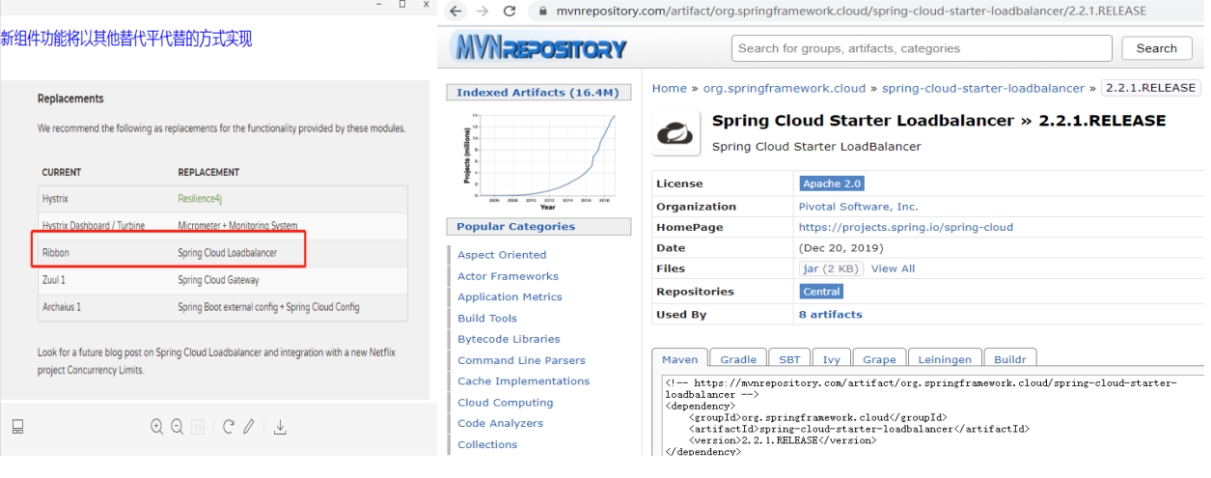
3.能干嘛
3.1 LB(负载均衡)
LB负载均衡(Load Balance)是什么
简单的说就是将用户的请求平摊的分配到多个服务上,从而达到系统的HA(高可用)。
常见的负载均衡有软件Nginx,LVS,硬件 F5等。
Ribbon本地负载均衡客户端 VS Nginx服务端负载均衡区别
Nginx是服务器负载均衡,客户端所有请求都会交给nginx,然后由nginx实现转发请求。即负载均衡是由服务端实现的。
Ribbon本地负载均衡,在调用微服务接口时候,会在注册中心上获取注册信息服务列表之后缓存到JVM本地,从而在本地实现RPC远程服务调用技术。
3.1.1 集中式LB
即在服务的消费方和提供方之间使用独立的LB设施(可以是硬件,如F5, 也可以是软件,如nginx), 由该设施负责把访问请求通过某种策略转发至服务的提供方;
3.1.2 进程内LB
将LB逻辑集成到消费方,消费方从服务注册中心获知有哪些地址可用,然后自己再从这些地址中选择出一个合适的服务器。
Ribbon就属于进程内LB,它只是一个类库,集成于消费方进程,消费方通过它来获取到服务提供方的地址。
二、Ribbon负载均衡演示
1.架构说明
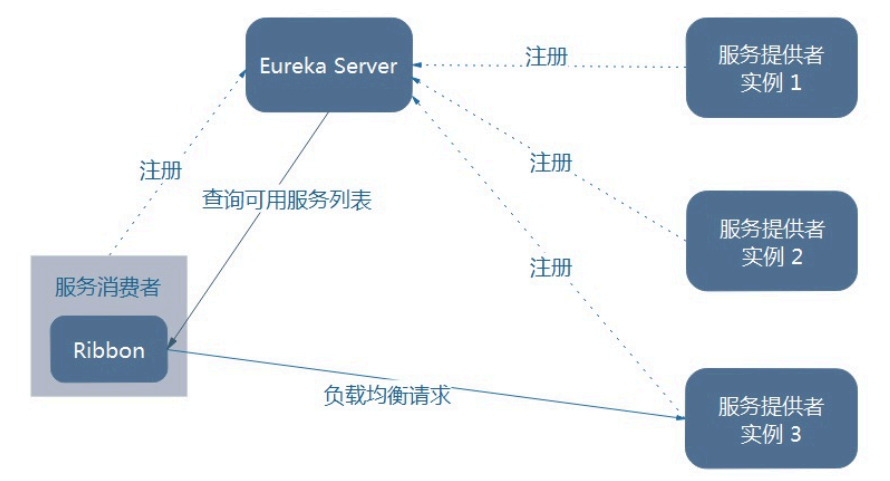
Ribbon在工作时分成两步
第一步先选择 EurekaServer ,它优先选择在同一个区域内负载较少的server.
第二步再根据用户指定的策略,在从server取到的服务注册列表中选择一个地址。
其中Ribbon提供了多种策略:比如轮询、随机和根据响应时间加权。
总结:Ribbon其实就是一个软负载均衡的客户端组件,
他可以和其他所需请求的客户端结合使用,和eureka结合只是其中的一个实例。
2.POM
之前写样例时候没有引入spring-cloud-starter-ribbon也可以使用ribbon
原因:
<dependency><groupId>org.springframework.cloud</groupId><artifactId>spring-cloud-starter-netflix-ribbon</artifactId></dependency>
猜测spring-cloud-starter-netflix-eureka-client自带了spring-cloud-starter-ribbon引用
证明如下: 可以看到spring-cloud-starter-netflix-eureka-client 确实引入了Ribbon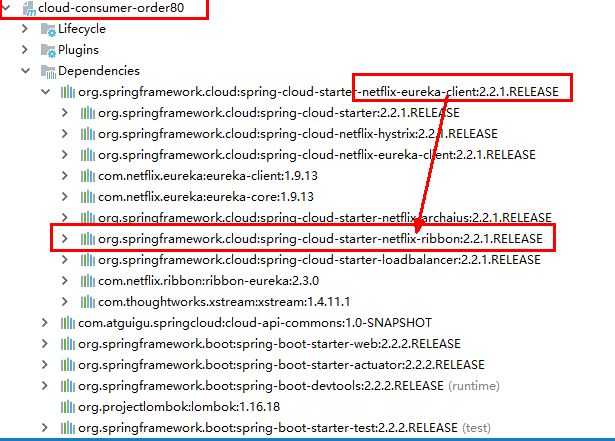
3.RestTemplate的使用
1.官网
https://docs.spring.io/springframework/docs/5.2.2.RELEASE/javadocapi/org/springframework/web/client/RestTemplate.html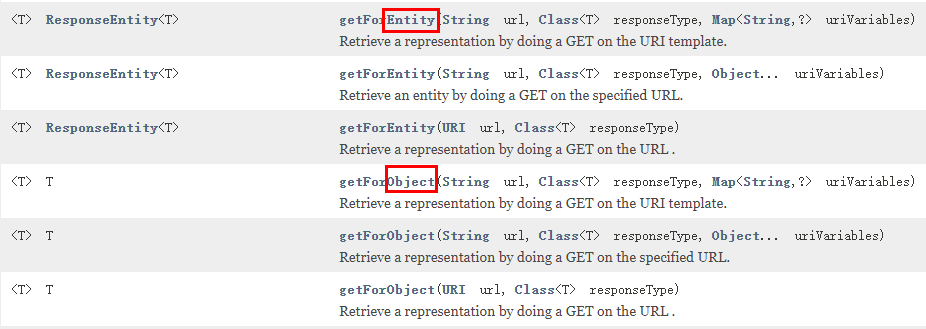
2.getForObject方法/getForEntity方法
返回对象为响应体中数据转化成的对象,基本上可以理解为Json

返回对象为ResponseEntity对象,包含了响应中的一些重要信息,比如响应头、响应状态码、响应体等

3.postForObject/postForEntity
4.GET请求方法
<T> T getForObject(String url, Class<T> responseType, Object... uriVariables);
<T> T getForObject(String url, Class<T> responseType, Map<String, ?> uriVariables);
<T> T getForObject(URI url, Class<T> responseType);
<T> ResponseEntity<T> getForEntity(String url, Class<T> responseType, Object... uriVariables);
<T> ResponseEntity<T> getForEntity(String url, Class<T> responseType, Map<String, ?> uriVariables);
<T> ResponseEntity<T> getForEntity(URI var1, Class<T> responseType);
5.POST请求方法
<T> T postForObject(String url, @Nullable Object request, Class<T> responseType, Object... uriVariables);
<T> T postForObject(String url, @Nullable Object request, Class<T> responseType, Map<String, ?> uriVariables);
<T> T postForObject(URI url, @Nullable Object request, Class<T> responseType);
<T> ResponseEntity<T> postForEntity(String url, @Nullable Object request, Class<T> responseType, Object... uriVariables);
<T> ResponseEntity<T> postForEntity(String url, @Nullable Object request, Class<T> responseType, Map<String, ?> uriVariables);
<T> ResponseEntity<T> postForEntity(URI url, @Nullable Object request, Class<T> responseType);
三、Ribbon核心组件IRule
1.IRule(负载均衡算法)
(1).com.netflix.loadbalancer.RoundRobinRule
(2).com.netflix.loadbalancer.RandomRule
(3).com.netflix.loadbalancer.RetryRule
先按照RoundRobinRule的策略获取服务,如果获取服务失败则在指定时间内会进行重试,获取可用的服务
(4).WeightedResponseTimeRule
对RoundRobinRule的扩展,响应速度越快的实例选择权重越大,越容易被选择
(5).BestAvailableRule
会先过滤掉由于多次访问故障而处于断路器跳闸状态的服务,然后选择一个并发量最小的服务
(6).AvailabilityFilteringRule
(7).ZoneAvoidanceRule
默认规则,复合判断server所在区域的性能和server的可用性选择服务器
2.如何替换?
1.修改cloud-consumer-order80
官方文档明确给出了警告:
这个自定义配置类不能放在@ComponentScan所扫描的当前包下以及子包下,
否则我们自定义的这个配置类就会被所有的Ribbon客户端所共享,达不到特殊化定制的目的了。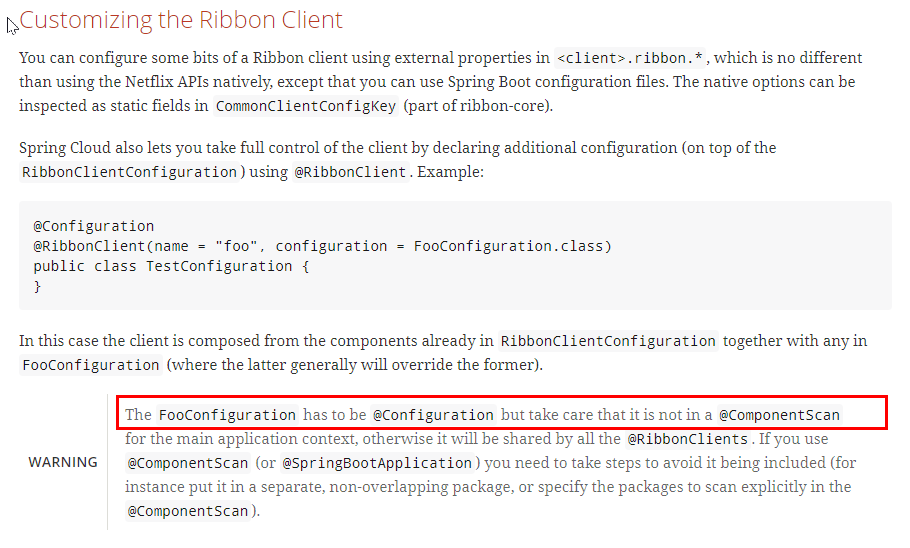
2.新建package
3.新建MySelfRule规则类
该类放在刚才创建好的myrule包下
package com.atguigu.myrule;
import com.netflix.loadbalancer.IRule;
import com.netflix.loadbalancer.RandomRule;
import org.springframework.context.annotation.Bean;
import org.springframework.context.annotation.Configuration;
@Configuration
public class MySelfRule
{
@Bean
public IRule myRule()
{
return new RandomRule();//定义为随机
}
}
4.主启动类添加@RibbonClient
package com.atguigu.springcloud;
import com.atguigu.myrule.MySelfRule;
import org.springframework.boot.SpringApplication;
import org.springframework.boot.autoconfigure.SpringBootApplication;
import org.springframework.cloud.netflix.eureka.EnableEurekaClient;
import org.springframework.cloud.netflix.ribbon.RibbonClient;
/**
* 在启动该微服务的时候就能去加载我们的自定义Ribbon配置类,从而使配置生效,形如:
* @RibbonClient(name = "CLOUD-PAYMENT-SERVICE",configuration= MySelfRule.class)
* name:表示去调用CLOUD-PAYMENT-SERVICE微服务
*
* 注意:微服务名称大写算法会改变成功,改为小写时还是默认的轮询算法(未改变)->亲测
*
*/
@EnableEurekaClient
@SpringBootApplication
@RibbonClient(name = "CLOUD-PAYMENT-SERVICE",configuration= MySelfRule.class)
public class OrderMain80 {
public static void main(String[] args) {
SpringApplication.run(OrderMain80.class,args);
}
}
5.测试
http://localhost/consumer/payment/get/31
四、Ribbon负载均衡算法
1.原理
负载均衡算法:rest接口第几次请求数 % 服务器集群总数量 = 实际调用服务器位置下标 ,
每次服务重启动后rest接口计数从1开始。
List
如: List [0] instances = 127.0.0.1:8002
List [1] instances = 127.0.0.1:8001
8001+ 8002 组合成为集群,它们共计2台机器,集群总数为2, 按照轮询算法原理:
当总请求数为1时: 1 % 2 =1 对应下标位置为1 ,则获得服务地址为127.0.0.1:8001
当总请求数位2时: 2 % 2 =0 对应下标位置为0 ,则获得服务地址为127.0.0.1:8002
当总请求数位3时: 3 % 2 =1 对应下标位置为1 ,则获得服务地址为127.0.0.1:8001
当总请求数位4时: 4 % 2 =0 对应下标位置为0 ,则获得服务地址为127.0.0.1:8002
如此类推……
2.RoundRobinRule源码
3.手写本地负载均衡器
3.1 7001/7002集群启动
3.2 8001/8002微服务改造
3.2.1 Controller
package com.atguigu.springcloud.controller;
import com.atguigu.springcloud.entities.CommonResult;
import com.atguigu.springcloud.entities.Payment;
import com.atguigu.springcloud.service.PaymentService;
import lombok.extern.slf4j.Slf4j;
import org.springframework.beans.factory.annotation.Value;
import org.springframework.cloud.client.ServiceInstance;
import org.springframework.cloud.client.discovery.DiscoveryClient;
import org.springframework.web.bind.annotation.*;
import javax.annotation.Resource;
import java.util.List;
@RestController
@Slf4j
public class PaymentController
{
@Value("${server.port}")
private String serverPort;
@Resource
private PaymentService paymentService;
@Resource
private DiscoveryClient discoveryClient;
@PostMapping(value = "/payment/create")
public CommonResult create(@RequestBody Payment payment)
{
int result = paymentService.create(payment);
log.info("*****插入操作返回结果:" + result);
if(result > 0)
{
return new CommonResult(200,"插入成功,返回结果"+result+"\t 服务端口:"+serverPort,payment);
}else{
return new CommonResult(444,"插入失败",null);
}
}
@GetMapping(value = "/payment/get/{id}")
public CommonResult<Payment> getPaymentById(@PathVariable("id") Long id)
{
Payment payment = paymentService.getPaymentById(id);
log.info("*****查询结果:{}",payment);
if (payment != null) {
return new CommonResult(200,"查询成功"+"\t 服务端口:"+serverPort,payment);
}else{
return new CommonResult(444,"没有对应记录,查询ID: "+id,null);
}
}
@GetMapping(value = "/payment/discovery")
public Object discovery()
{
List<String> services = discoveryClient.getServices();
for (String element : services) {
System.out.println(element);
}
List<ServiceInstance> instances = discoveryClient.getInstances("CLOUD-PAYMENT-SERVICE");
for (ServiceInstance element : instances) {
System.out.println(element.getServiceId() + "\t" + element.getHost() + "\t" + element.getPort() + "\t"
+ element.getUri());
}
return this.discoveryClient;
}
@GetMapping(value = "/payment/lb")
public String getPaymentLB()
{
return serverPort;
}
}
3.3 80订单微服务改造
3.3.1 ApplicationContextBean去掉注解@LoadBalanced
package com.atguigu.springcloud.config;
import org.springframework.cloud.client.loadbalancer.LoadBalanced;
import org.springframework.context.annotation.Bean;
import org.springframework.context.annotation.Configuration;
import org.springframework.web.client.RestTemplate;
@Configuration
public class ApplicationContextBean
{
@Bean
//@LoadBalanced
public RestTemplate getRestTemplate()
{
return new RestTemplate();
}
}
3.3.2 LoadBalancer接口
package com.atguigu.springcloud.lb;
import org.springframework.cloud.client.ServiceInstance;
import java.util.List;
public interface LoadBalancer
{
ServiceInstance instances(List<ServiceInstance> serviceInstances);
}
3.3.3 MyLB
package com.atguigu.springcloud.lb;
import org.springframework.cloud.client.ServiceInstance;
import org.springframework.cloud.client.loadbalancer.LoadBalanced;
import org.springframework.stereotype.Component;
import java.util.List;
import java.util.concurrent.atomic.AtomicInteger;
@Component
public class MyLB implements LoadBalancer
{
private AtomicInteger atomicInteger = new AtomicInteger(0);
public final int getAndIncrement()
{
int current;
int next;
do
{
current = this.atomicInteger.get();
next = current >= 2147483647 ? 0 : current + 1;
} while(!this.atomicInteger.compareAndSet(current, next));
System.out.println("*****next: "+next);
return next;
}
@Override
public ServiceInstance instances(List<ServiceInstance> serviceInstances)
{
int index = getAndIncrement() % serviceInstances.size();
return serviceInstances.get(index);
}
}
3.3.4 OrderController
package com.atguigu.springcloud.controller;
import com.atguigu.springcloud.entities.CommonResult;
import com.atguigu.springcloud.entities.Payment;
import com.atguigu.springcloud.lb.LoadBalancer;
import org.springframework.beans.factory.annotation.Autowired;
import org.springframework.cloud.client.ServiceInstance;
import org.springframework.cloud.client.discovery.DiscoveryClient;
import org.springframework.http.ResponseEntity;
import org.springframework.web.bind.annotation.GetMapping;
import org.springframework.web.bind.annotation.PathVariable;
import org.springframework.web.bind.annotation.RequestParam;
import org.springframework.web.bind.annotation.RestController;
import org.springframework.web.client.RestTemplate;
import javax.annotation.Resource;
import java.net.URI;
import java.util.List;
@RestController
public class OrderController
{
//public static final String PAYMENT_SRV = "http://localhost:8001";
public static final String PAYMENT_SRV = "http://CLOUD-PAYMENT-SERVICE";
@Resource
private RestTemplate restTemplate;
//可以获取注册中心上的服务列表
@Resource
private DiscoveryClient discoveryClient;
@Resource
private LoadBalancer loadBalancer;
@GetMapping("/consumer/payment/create")
public CommonResult<Payment> create(Payment payment)
{
return restTemplate.postForObject(PAYMENT_SRV+"/payment/create",payment,CommonResult.class);
}
@GetMapping("/consumer/payment/get/{id}")
public CommonResult<Payment> getPayment(@PathVariable("id") Long id)
{
return restTemplate.getForObject(PAYMENT_SRV+"/payment/get/"+id,CommonResult.class);
}
@GetMapping("/consumer/payment/getForEntity/{id}")
public CommonResult<Payment> getPayment2(@PathVariable("id") Long id)
{
ResponseEntity<CommonResult> entity = restTemplate.getForEntity(PAYMENT_SRV+"/payment/get/"+id, CommonResult.class);
if(entity.getStatusCode().is2xxSuccessful()){
return entity.getBody();
}else {
return new CommonResult(444, "操作失败");
}
}
@Resource
private LoadBalancer loadBalancer;
@GetMapping("/consumer/payment/lb")
public String getPaymentLB()
{
List<ServiceInstance> instances = discoveryClient.getInstances("CLOUD-PAYMENT-SERVICE");
if(instances == null || instances.size()<=0) {
return null;
}
ServiceInstance serviceInstance = loadBalancer.instances(instances);
URI uri = serviceInstance.getUri();
return restTemplate.getForObject(uri+"/payment/lb",String.class);
}
}

